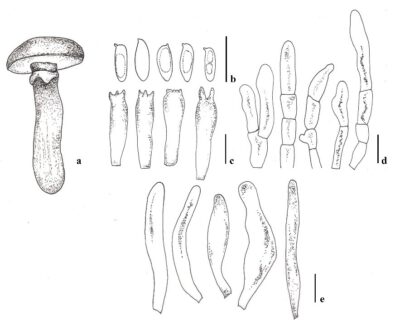Fungalpedia – Note 145 Suillus
Suillus Gray
Citation if using this entry: Bera et al. (in prep) – Fungalpedia, Basidiomycota 1. Mycosphere.
Index Fungorum, MycoBank, Facesoffungi, GenBank, Fig. 1
Suillaceae, Boletales, Agaricomycetes, Basidiomycota, Fungi
Gray (1821) established Suillus to encompass the mushrooms characterized by a centrally attached stipe with a distinct ring, a circular pileus, and a poroid hymenium with closely adhering tubes. Typified by Suillus luteus (L.) Roussel, this genus has been classified under the order Boletales (Hawksworth et al. 1995). The pileus of Suillus can vary from viscid to glutinous to completely dry and scaly (Dahlberg & Finlay 1999). The stipe can be with or without the ring (Dahlberg & Finlay 1999). The basidiospores are usually brownish-pigmented, shaped elongated with smooth surfaces (Dahlberg & Finlay 1999). Clamp connections are either absent or very rare (Dahlberg & Finlay 1999). The presence of the cystidia in the hymenium in the species of Suillus completely distinguishes the genus from the other taxa of Boletales (Pegler & Young 1981, Dahlberg & Finlay 1999). The extreme host-specificity of Suillus with Pinaceae makes the genus ideal for research in ectomycorrhizal phylogeny, their biogeography, and the coevolution of the host plants and the associated fungus (Kretzer et al. 1996, Manian et al. 2001, Mueller et al. 2001, Wu et al. 2000). The pioneer work on unveiling Suillus diversity was done by Smith and Thiers (1964). Over the years, globally, the conventional taxonomic studies of Suillus have been carried out by Thiers (1975), Both (1993), Bessette et al. (2000), Kibby (2011), Klofac (2013), Verma and Reddy (2014), Sarwar et al. (2015), and Zhang et al. (2017). Besides the morphological character-based identification, molecular studies mostly based on nrITS region have been undertaken for Suillus. However, Zhang et al. (2017) studied the phylogeny of the Suillus spraguei (Berk. & M.A. Curtis) Kuntze complex based on nrITS, nrLSU, tef1, and rpb1 sequence data. Currently, there have been approximately 112 species documented under Suillus (http://www.mycobank.org/, https://www.speciesfungorum.org/).
Synonyms: Boletinus Kalchbr., Boletopsis Henn., Boletus sect. Viscipellis Fr., Cricunopus P. Karst., Euryporus Quél., Fuscoboletinus Pomerl. & A.H. Sm., Gastrosuillus Thiers, Gymnopus (Quél.) Quél. ex Moug. & Ferry, Ixocomus Quél., Mariaella Šutara, Peplopus (Quél.) Quél. ex Moug. & Ferry, Pinuzza Gray, Rostkovites P. Karst., Solenia Hill ex Kuntze, Viscipellis (Fr.) Quél., Viscipellis subgen. Gymnopus Quél., Viscipellis subgen. Peplopus Quél.
Type species: Suillus luteus (L.) Roussel
Other accepted species: Refer Species Fungorum (https://www.speciesfungorum.org/)
Figure 1. a. Suillus luteus (Smith 64548), b–e. Microscopic characters of Suillus quiescens. a. Basidiomata. b. Basidiospores. c. Basidia. d. Cheilocystidia. E. Caulocystidia. Scale bars: b–e = 10 μm. Drawn from a = Smith & Thiers 1964, b–e =Bruns et al. 2010.
References
Bessette AE, Bessette AR, Roody WC 2000 – North American Boletes: a color guide to the fleshy pored mushrooms. Syracuse University Press. 396 p.
Both EE 1993 – The boletes of North America: a compendium. Buffalo, New York: Buffalo Museum of Science Press. 436 p.
Bruns TD, Grubisha LC, Trappe JM, Kerekes JF, Vellinga EC 2010 – Suillus quiescens, a new species commonly found in the spore bank in California and Oregon. Mycologia, 102(2), 438–446.
Dahlberg A, Finlay RD 1999 – Suillus. Ectomycorrhizal fungi key genera in profile, 33–64.
Gray SF 1821 – A Natural Arrangement of British Plants. Baldwin, Cradock, and Joy, London, UK, 646 p.
Hawksworth DL, Kirk PM, Sutton BC, Pegler DN 1996 – Ainsworth & Bisby’s dictionary of the fungi. Revista do Instituto de Medicina Tropical de São Paulo, 38, 272 p.
Kibby G 2011 – British boletes with keys to species. UK: Geoffrey Kibby. 73 p.
Klofac W 2013 – A world-wide key to the genus Suillus. Österreichische Zeitschrift für Pilzkund, 22, 211–278.
Kretzer A, Li Y, Szaro T, Bruns TD 1996 – Internal transcribed spacer sequences from 38 recognized species of Suillus sensu lato: phylogenetic and taxonomic implications. Mycologia, 88(5), 776–785.
Manian S, Sreenivasaprasad S, Bending GD, Mills PR 2001 – Genetic diversity and interrelationships among common European Suillus species based on ribosomal DNA sequences. FEMS Microbiology Letters, 204(1), 117–121.
Mueller GM, Wu QX, Huang YQ, Guo SY, Aldana‐Gomez R, Vilgalys R 2001 – Assessing biogeographic relationships between North American and Chinese macrofungi. Journal of biogeography, 28(2), 271–281.
Pegler DN, Young TWK 1981 – A natural arrangement of the Boletales, with reference to spore morphology. Transactions of the British Mycological Society, 76(1), 103–146.
Sarwar S, Saba M, Khalid AN, Dentinger BM 2015 – Suillus marginielevatus, a new species and S. triacicularis, a new record from Western Himalaya, Pakistan. Phytotaxa, 203(2), 169–177.
Smith AH, Thiers HD 1964 – Contributions Toward a Monograph of North American Species. Lubrecht & Cramer. 116 p.
Thiers HD 1975 – California mushrooms: a field guide to the boletes. New York, New York: Hafner Press. 261 p.
Verma B, Reddy MS 2014 – Suillus triacicularis sp. nov., a new species associated with Pinus roxburghii from northwestern Himalayas, India. Phytotaxa, 162(3), 157–164.
Wu QX, Mueller GM, Lutzoni FM, Huang YQ, Guo SY 2000 – Phylogenetic and biogeographic relationships of eastern Asian and eastern North American disjunct Suillus species (Fungi) as inferred from nuclear ribosomal RNA ITS sequences. Molecular phylogenetics and evolution, 17(1), 37–47.
Zhang R, Mueller GM, Shi XF, Liu PG 2017 – Two new species in the Suillus spraguei complex from China. Mycologia, 109(2), 296–307.
Entry by
Ishika Bera, Center of Excellence in Fungal Research, Mae Fah Luang University, Chiang Rai 57100, Thailand
(Edited by Kevin D Hyde)
Published online 3 October 2023
